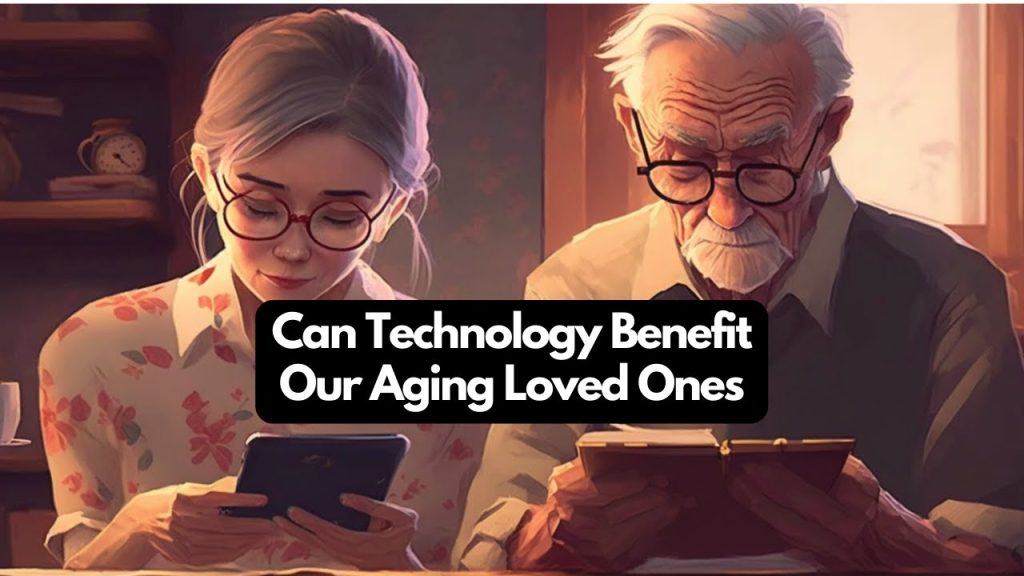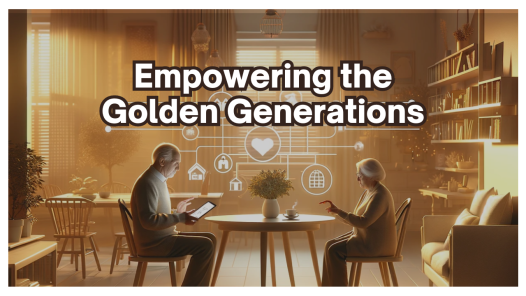In this episode 2, of our 3 part series, we’ll explore how new technology can benefit our aging loved ones. From staying connected to living independently, we’ll see how technology can help our loved ones stay independent and engaged in their lives.
Technology is changing rapidly, and it’s important that we’re aware of the benefits and how it can help our loved ones. In this podcast episode, we’ll explore how new technology can benefit seniors and help them stay connected and engaged in their lives. We hope you enjoy learning about this important topic!
As we live longer and healthier lives, aging no longer means what it used to. Older adults are active, engaged members of society who use technology to stay connected with family and friends, manage their finances, stay healthy, and pursue their hobbies and interests.
Technology has revolutionized health care, making it possible to monitor our health in ways that were unimaginable just a few years ago. Fitness trackers, digital pillboxes, and mobile apps allow us to track our physical activity, sleep patterns, medications, and diet. This data can be used to identify trends and make lifestyle changes that can improve our health and well-being.
For older adults living with chronic conditions such as heart disease, diabetes, or COPD, technology can be a vital tool for managing their health. Digital health tools can help them track their symptoms and medication use, schedule doctor’s appointments and medication refills and connect with their care team.
However, it can also present challenges, such as those related to privacy and security. Ultimately, the decision of when and how to use technology in the care of older adults should be made by the older adults themselves, in consultation with their families and caregivers.
Technology has the potential to greatly improve the lives of older adults. It is important that we continue to explore ways to incorporate it into our caregiving practices in a way that is respectful of the needs and preferences of our patients.
Topics I will discuss in this episode include:
✅ What types of technologies are used in health management for older adults?
✅ What are the benefits of using technology to manage the health of older adults?
✅ What challenges do older adults face in using digital health tools?
✅ How do technologies help seniors manage chronic conditions?
✅ What are the best practices for incorporating technology into senior care?
✅ Who decides when and how to use technology in senior care?
✅ How do families and caregivers feel about using technology in the care of their loved ones?
✅ How do seniors feel about health tech?
✅ How can we ensure that technology is used safely and effectively in the care of older adults?
✅ What are some of the risks of using technology later in life?
✅ What challenges does aging pose for the development of digital health solutions?
✅ How can the tech industry & the aging community collaborate to innovate accessible technology?
✅ How will advances in technology impact the way we monitor & manage health in older adults?
Listen to part 1: “Hanh Brown – Technology and Older Adults: 10 Things You Need to Know”
Listen to part 1 on Apple Podcasts
👉 See our Website: https://podcast.boomerliving.tv/
🎙 Boomer Living Podcast: https://hanhdbrown.com/
👉 LinkedIn https://bit.ly/2TFIbbd
Transcript:
Hi, I’m Hanh Brown, the host of the Boomer Living Broadcast. Welcome. We’re delighted that you could join us today. I know there are people all over the world who share my interests to learn and to share ideas how to best serve the aging population. So good morning, good afternoon, and good evening to you. Well, this is a three-part event series on older adults and technology. The first one was “Technology and Older Adults, 10 Things You Need to Know.” The link for this event is in the comments, so please feel free to check it out. So today’s topic is “Technology and Health Management in Older Adults.” As we live longer and healthier lives, aging no longer means what it used to. Older adults are active, engaged members of society who are using technology to stay connected with family and friends, manage their finances, stay healthy, and pursue their hobbies and interests. Technology has revolutionized health care, making it possible to monitor our health in ways that were unimaginable years ago. Fitness trackers, digital pill boxes, and mobile apps allow us to track our physical activities, sleep patterns, medications, and diet. This data can be used to identify trends and make lifestyle changes that can improve our health and well-being.
For seniors living with chronic conditions such as heart disease, diabetes, or COPD, technology can be a vital tool for managing their health. Digital health tools can help them track their symptoms and medication use, schedule doctor appointments and medication refills, and connect them with their care team. However, it can also present challenges such as those related to privacy and security. Ultimately, the decision of when and how to use technology in the care of seniors should be made by the seniors themselves in consultation with their families and caregivers. Technology has the potential to greatly improve the lives of seniors. It’s important that we continue to explore ways to incorporate it into our caregiving practices in a way that is respectful of the needs and preferences of the patient. So today’s topic is “Technology and Health Management in Older Adults.” And here are 10 things that you need to know. First, what types of technologies are used in health management for older adults? Second, what are the benefits of using technology to manage health of older adults? Third, what challenges do older adults face in using digital health tools? Fourth, how do technologies help seniors manage chronic conditions? Five, what are the best practices for incorporating technology into senior care? Six, who decides when and how to use technology in senior care? Seven, how do family and caregivers feel about using technology in care of their loved ones? Eight, how do seniors feel about health tech?
Nine, what challenges does aging pose for the development of digital health solutions? Ten, how can tech industry and the aging community collaborate to innovate accessible technology? Eleven, how will advances in technology impact the way we monitor and manage health in older adults? And twelve, how sales and marketing automation can benefit tech companies serving seniors? So the first topic is what types of technologies are used in health management for older adults? Well, there are a lot of technologies out there that can help with health management for seniors. Some of them are pretty simple, like pedometers to track steps taken or apps to remind you to take your medication. Others are more complex, like electronic medical records that keep track of your health history or wearable devices that monitor your vital signs. Well, here are 10 technologies that are commonly used in health management for seniors. Pedometers or activity trackers. These can be worn on your wrist or clipped to your clothing, and they track how many steps that you take throughout the day. They can also sometimes track other activities like swimming or cycling. Medication reminder apps. There are a lot of these on the market, and they can range from very simple just setting an alarm to more complex, including features like refill reminders and dosage information. Electronic medical records. These are becoming more and more common, and they allow your doctors to have access to your complete health history in one place. Watchful waiting technologies. These technologies monitor vital signs like heart rate, blood pressure, and oxygen level.
They can be worn as watches or as patches on the skin and often have alarms that go off if something seems abnormal. GPS tracking devices. These can be helpful if you have Alzheimer’s or other condition that makes it easy to get lost. The devices can be worn as bracelets or pendants, and they use GPS to track your location so that you can be found if you wander off. Fall detection devices. These technologies use sensors to detect when a person has fallen, and they can either send an alert to a caregiver or automatically call for help. Video conferencing. This is a great way to stay in touch with loved ones who live far away, and it’s also becoming more common for doctor appointments and other types of health care visits. Virtual reality. Some companies are using virtual reality to help people with dementia reconnect with memories from the past, and it’s also being used in some physical therapy programs. 3D printing. This technology is being used in a variety of ways in health care, from creating customized prosthetics to printing human tissue for research purposes. Technologies are used in health management for seniors to improve their quality of life. These technologies can monitor health parameters, help caregivers, and manage medication. Common technologies for older adults health management include, first, wearable technologies such as fitness trackers. These can be used to monitor heart rate, steps taken, and other health metrics. Second, telehealth technologies. These enable remote monitoring of patients by doctors and nurses and can be used to provide care and support to patients in their own home. Third, technology assisted living. This includes technologies that can help with day to day tasks such as cooking, cleaning, and laundry.
Fourth, mobility technologies. These can help seniors to get around more easily, whether that’s by providing information on route and transport options or by helping with things like opening doors and carrying groceries. Fifth, communication technologies. These enable seniors to stay in touch with family and friends, whether that’s through video calling, social media, or simply sending emails or text messages. Sixth, memory aids. These can be digital or physical technologies that help remind people of things like appointments, medication schedules, and important phone numbers. Ninth, brain training technologies. There are a number of apps and games available to, well, claim to help improve cognitive function in seniors. Ten, connected home technologies. These are devices and systems that work together to make it easier to live independently at home. For example, by automatically turning lights off when nobody is home or by sending alerts if an appliance has been left on for too long. While some of these technologies are still in the early stages of development and testing, others are widely available and show promise for improving the health and well-being of seniors. Second topic is, what are the benefits of using technology to manage the health of older adults? Well, as our population ages, it’s becoming increasingly important to find ways to help seniors stay healthy and independent for as long as possible. Technology can play a big role in this, providing tools to help with everything from managing medications to staying connected with loved ones. Well, here are 10 benefits of using technology to manage the health of older adults. First, improved medication compliance. Medication management apps can remind patients to take their pills and share information with caregivers and doctors. This ensures patients take their medication as prescribed, improving health and well-being. Second, avoidance of hospital readmissions.
Telehealth services allow patients to receive care from home, which can help prevent costly and disruptive hospital readmissions. Third, early detection of health problems. Tools like fitness trackers and blood pressure monitors can help identify early signs of health problems so that intervention can be taken before the problem becomes more serious. Fourth, improved communication with health care providers. Technology can provide patients with easy access to their health care providers, whether it’s through online portals, email, or text messaging. This improved communication can lead to better overall care. Fifth, greater independence and autonomy. Technologies like personal emergency response systems and medication management systems can give seniors the ability to live independently for longer periods of time. Sixth, better management of chronic conditions. Chronic disease management apps can help patients track their symptoms and progress and share information with their physicians. This can lead to better overall management of chronic conditions such as diabetes, heart disease, and respiratory illness. Seven, enhanced social connectedness. Social media platforms and video chat software provide opportunities for seniors to stay connected with family and friends, even if they can’t meet in person regularly. This can help reduce feelings of isolation and loneliness, which are associated with poor health outcomes. Eight, improved mental health. Along with increased social connectedness, technology can also provide opportunities for mental stimulation and cognitive engagement. This can help improve mental health in seniors by reducing depression and anxiety symptoms. Nine, increased physical activity levels. Physical activity is important for maintaining good health as we age, but it can be difficult to stay motivated. Activity tracking apps and wearable devices provide encouragement and feedback that can help people stay on track with their physical activity goals.
There are many different types of technology available to choose from, so it’s important to do some research and find the best option for each individual. The third topic is, what challenges do older adults face in using digital health tools? As more and more of us turn to digital health tools to track our progress, monitor our health, and stay up to date with the latest health care news, it’s important to consider how seniors can also benefit from these tools. While digital health tools are increasingly accessible for everyone, there are some unique challenges that seniors face when using them. So let’s take a look at some of these challenges. First, accessibility. Many digital health tools require an internet connection or a device like a smartphone or tablet to assess them. Not all seniors have access to these technologies or necessary skills to use them effectively. Second, affordability. Similar to accessibility, affordability can be a challenge for many seniors who may not have the resources available to purchase the necessary equipment and subscription fees associated with certain digital health tools. Third, security. Seniors may not be aware of the potential security risks associated with using the digital health tools and could unknowingly put their personal information at risk if they don’t take proper precautions. Fourth, privacy. In order for many digital health tools to work properly, users must provide personal information such as medical histories and insurance details in order for them to function properly. Many seniors may not be comfortable sharing this kind of sensitive information online due to privacy concerns. Fifth, complexity. Digital health tools can be complicated and confusing for those who aren’t tech savvy or familiar with how to how they work. So this could cause confusion and frustration, which could deter older users from utilizing the available options effectively. Sixth, overload of information.
So much information online can be overwhelming for senior consumers who aren’t used to navigating large amount of data quickly or parsing what’s relevant versus what’s not as they research for medical topics online. Seven, lack of social interaction. Digital health solutions are often impersonal, making it difficult for senior consumers who need more social interaction to understand how the tool works for them. Eight, difficulty adapting. Many seniors have trouble adapting due to physical or mental decline, making learning complex new systems more difficult. Nine, technical support. It’s hard for seniors living alone without family to get help with digital health solutions because it’s hard to find someone knowledgeable or willing to help. Ten, lack of personalization. Many digital health solutions are designed on a mass scale. So individuals may not be considered when creating features. Senior consumers may have trouble using a tool that isn’t tailored to his or her needs. Digital health tools can benefit seniors if used correctly, but they also pose some challenges. It’s important to ensure that everyone has access, understands security risks, is comfortable with privacy issues, knows how they work, isn’t overwhelmed by too much information, has support if needed, can adapt quickly enough, and receives personalized features based on their needs when using these powerful resources. The fourth topic is how do technologies help seniors manage chronic conditions? Well, in recent years, there have been significant advances in technology that have helped people of all ages to better manage their chronic conditions. For seniors who are often dealing with multiple chronic conditions, these technologies can be lifesavers. Well, here are 10 explanations for how effective technologies are in assisting seniors in managing chronic conditions. First, they help to track and manage medications. Seniors often take multiple medications, which can be difficult to keep track of.
So pill boxes and medication reminder apps can help ensure medications are taken on time and in correct dosage. Second, they provide easy access to medical records. Well, in the past, assessing medical records was a very time consuming and complicated process. With electronic health records, patients can easily view their own medical history and share it with their care team. Third, they facilitate remote appointments. Technology allows patients to consult with their doctors from home. This is especially helpful for seniors who may have trouble getting to a doctor’s office. Four, they help with communication. Technologies like video conferencing and instant messaging improve communication between patients and the care teams. This ensures everyone understands the treatment plans and goals. Five, they promote healthy behaviors. Many wearable technologies track fitness and activity levels, as well as heart rate and blood pressure. These devices can encourage exercise and healthy eating. Six, they provide social support. Social media and online support groups can help isolated or lonely seniors. These connections reduce isolation and boost mental health. Seven, they offer educational resources. The internet has many resources to help seniors understand their chronic conditions. Patient education materials are available online 24-7, empowering patients to take an active role in their health care. Eight, they increase access to care.
In rural or low public transportation areas, getting to the doctor can be very difficult. Telehealth services allow patients to consult with their doctors via video conference or phone. Nine, they monitor vital signs. There are many devices that monitor vital signs from home. This information can help identify potential problems early and seek prompt medical attention. Ten, they provide a peace of mind. Technology can give patients and their caregivers peace of mind. Patients can use technology to feel more connected to their care team when they’re not present. So the fifth topic is, what are some best practices for incorporating technology into the care of older adults? As our aging population continues to grow, it is becoming increasingly important to find ways to incorporate technology in their care. There are many potential benefits to using technology to assist seniors, including improved communication, increased independence, and enhanced safety. However, it’s important to use technology in a way that respects the individual’s privacy and dignity. With that in mind, here are 10 practices for incorporating technology into the care of seniors. First, get consent. Before introducing any new technology, keep it simple. Use user-friendly devices and software. Respect privacy. Avoid sharing personal information without permission. Be aware of scams. Educate seniors about how to stay safe online.
Promote independence. Help seniors learn how to use new technologies. Enhance safety. Use technology to monitor health and well-being. Encourage socialization. Use technology to connect with friends and family. Promote physical activities. Use technology to encourage healthy habits. Be patient. Take the time to answer questions and provide support. Evaluate regularly. Well, check in with seniors to see how they are using new technologies and if they need help troubleshooting any issues. By following these best practices, it will help ensure that technology is used in a way that benefits seniors while respecting their rights and needs. Topic 6. Who determines when and how technology should be used in the care of older adults? Well, the fact is, there is no one-size-fits-all answer to this question. The decision about when and how to use technology in the care of seniors is made by a team of experts. This team includes doctors, nurses, therapists, and social workers. The decision is based on the needs of the individual and made with the input of the family and caregivers. The goal is to improve their quality of life.
It is made on a case-by-case basis. There is no one-size-fits-all approach. The use of technology in the care of seniors is a very complex and often controversial issue. There is no central policy governing the use of technology in the care of seniors. Decisions are typically made at the state or local level. There is also no consensus among experts about when and how to use technology in the care of seniors. Technology can be beneficial for some seniors. It can also be harmful for others. Technology can be used to help seniors to stay independent, but it also can be used to control them. Who makes decisions about the use of technology in the care of seniors often depends on who pays for the technology. Technology is often used more for surveillance than for caregiving in institutional settings. As the population of seniors continues to grow, this is an issue that will likely receive increasing attention from policymakers, providers, and families alike. Well, here are some considerations. The decision-maker should ensure that any proposed technological solution is appropriate for the patient’s age, physical ability, cognitive abilities, and overall health status. The decision-maker should consider whether the risk of using technology outweighs its potential benefits for the patient being treated.
If a particular piece of technology would be beneficial for a patient, the decision-maker should consider its cost-effectiveness and practicality, in other words, ease of use for both health care providers and patients. Any technological solution for caring for seniors must ensure patient confidentiality and safety. It’s important for all parties involved, including family members, health care professionals, to work together collaboratively when deciding on an appropriate technological solution for an older adult patient’s care needs to maximize its effectiveness and minimize any potential risk. All decisions regarding the use of technology in caring for seniors should consider ethical consideration, such as respect for autonomy and beneficence, doing what is best for patients. Families can influence decisions about using technology to care for an older adult, especially if that person lacks decision-making capacity or needs assistance with daily living. Technology should never replace human interaction between health care professionals and patients. It should be used to improve communication and outcomes. Senior living communities may use GPS tracking systems or facial recognition software to improve security or support services. All stakeholders, including family, caregivers, and residents, should weigh in. Nursing homes must comply with applicable laws and regulations before implementing new technologies, including obtaining staff consent if required HIPAA privacy rule. There are many factors involved in deciding whether or not to use technology in the care of seniors.
It’s important that all stakeholders have input into these decisions so that they can be tailored to individual needs while also taking compliance requirement into account such as HIPAA privacy rule. Topic 7. How do family members and caregivers feel about using technology in the care of their loved one? Technology has the potential to greatly improve the experience of caregiving for both family members and caregivers. But what do those who use it really think? Well, to get a better picture of how technology is being adapted in caregiving, let’s take a look at 10 facts about how family members and caregivers feel about using technology in the care of their loved ones. According to the survey conducted by Phillips Home Care Solution, 97% surveyed family members said they would recommend technology-assisted caregiving to other families. 88% of surveyed family members believe that using technology has allowed them to spend more quality time with their loved one. 83% of surveyed family members consider themselves early adapters when it comes to technologies that support caregiving. A study conducted by Caring Village found that 84% of respondents had used technology to monitor their loved one’s condition or activities while they were away from home.
79% of surveyed caregivers consider technology an important part of providing quality care for their loved ones. 72% of surveyed caregivers say they are more likely to use technologies if they can be integrated with existing products and services already in place for their loved one’s care needs. 68% respondents in a study by the Caring Village said that using technology made them feel more secure about the safety and well-being of their loved one when they weren’t present. 65% of surveyed caregivers believe that using technology enhances communication between them and their loved one. 61% of surveyed family members believe that using technology has improved the overall quality of life for their loved one. 55% surveyed caregivers believe that using technology allowed them to provide better, more comprehensive care for their loved one. Technology has become an important tool in providing quality care for seniors or disabled. The benefits of adapting technological solutions are clear, from enhancing caregiver-patient communication to allowing families more quality time together. Those who have done so overwhelmingly express positive sentiment about its use in providing better care overall.
So it’s encouraging to see how far we have come in adapting technological solutions into our daily lives. So let’s not forget the impact all this can have on those in need. Topic 8. How do seniors feel about using technology to manage their health? Seniors are more than ever willing to adapt technology in their lives to help manage their health. From virtual doctor appointments to using wearables, seniors are becoming tech savvy when it comes to managing their health. Well, here are 10 facts about seniors, how they feel about using technology to manage their health. First, the AARP found that 72% of seniors believe technology can improve their health and well-being. 95% of seniors age 65 plus have access to a computer or smartphone and use it for emailing, browsing the internet, and playing games. 60% of seniors surveyed by the National Council of Aging said they would use telehealth if it was available. The Journal of American Medical Association article found that seniors who use telemedicine were more satisfied with their care and had better communication with their healthcare provider. 69% of seniors said they would use a smartwatch or fitness tracker
if it was recommended by a healthcare provider. The Stanford University found that remote monitoring via smartwatches improved outcomes for seniors with chronic conditions like hypertension, diabetes, congestive heart failure. According to the National Institute of Aging, 75% of seniors prefer using online methods to communicate with healthcare providers about prescription refills and test results. A study in the gerontology and geriatric education found that seniors 65 plus who use wearables had better medication adherence rates. The same study found that 89% of seniors, 65 plus, felt more empowered when tracking their own health data via wearables than traditional methods such as paper charts or memory aids. Research now found that 70% of seniors think online healthcare advice is important because it helps them manage their own health. So seniors are increasingly using technology to manage their health due to convenience, accuracy, and cost savings that it offers. Most seniors are willing to try new technologies if they believe it will make managing their daily life and health decisions easier. This highlights the need for proactive outreach from healthcare providers
when offering educational resources on telehealth visits, online patient portals, and other digital services available within the provider’s practice area. Topic 9. So what challenges does aging present for the development of digital health solutions? As our population ages, the need to develop digital health solutions becomes ever more important. These solutions can provide seniors with a greater sense of security and better access to medical care. However, there are certain challenges that must be taken into account when developing these solutions. Well, let’s take a look at 10 facts about these challenges. Accessibility and usability. Seniors may have difficulty using technology due to physical limitations or lack of familiarity with certain devices. So it’s important that any digital health solution be designed with accessibility and usability in mind so that it can be used by seniors as easily as possible. Memory issues. Memory loss makes it difficult for seniors to remember instructions or use a device correctly.
Memory loss can make it hard for seniors to understand why they should use a device or service, reducing usage and adaption. Physical limitation. Many seniors with physical limitations can’t use tablets or smartphones. To be effective for this population, digital health solutions must be designed with these limitations in mind so that all users can access them and use them properly. Privacy concerns. Seniors are often more privacy conscious than younger users and may not want to share personal information online or on a mobile device. Any digital health solution must take this into account and provide adequate security and data safeguards. Cognitive decline. Cognitive decline makes it hard for seniors to understand how a device works or why they should use it. This can cause user frustration and lower adaption rates if not addressed during the solution development. Lack of education. Some seniors lack basic computer literacy, which makes using technology difficult,
especially when trying something new, like digital health solutions designed for their age group. So often, these users don’t have access to educational resources that could help them become more comfortable technology outside of the healthcare setting. Poor understanding of benefits. Some seniors may not understand the benefits of digital health solutions, such as improved healthcare outcomes and lower cost. This demographic must understand and accept the benefits for them in order to be accepted. Lack of resources for training and support. Even after training on how to use digital health solutions, seniors may need additional support once they start using them. People learn differently and at different rates, so they may need online tutorials, user forms, and so forth. Cost barriers. Cost barriers prevent many seniors on fixed incomes from using tablets or smartphones to access digital health services tailored to their age group. Purchasing data plans for these devices may be cost prohibitive,
unless healthcare providers subsidize them. Limited interoperability. With many different types of healthcare providers offering different services, interoperability allows data sharing in communication that might otherwise be difficult due to differences in systems used by each provider. Healthcare systems are fragmented, making it difficult for users to access certain services. They may not know where to go or what type of service available in their area without first speaking to their doctor or other healthcare providers. Cultural acceptance. Well, cultural acceptance is key when introducing new technologies to any population. As some cultures may view certain technologies as foreign or uncomfortable, which could hinder adoption rates among certain groups, especially senior communities. Creating digital health solutions
that meet the needs of age and population requires careful consideration of multiple factors so that all users feel comfortable using them. Proper planning during solution design process will ensure successful implementation and improve quality now and in the future. Topic 10. What opportunities exist for collaboration between the tech industry and the aging community in terms of innovation around accessible technology? As the population of seniors continues to grow, so too does the need for accessible technology innovation. Technology has great potential to improve the quality of life for seniors by providing access to communication, transportation, health information, and much more. As the baby boomer population ages, demand for product and services designed for them will rise. So tech companies can develop innovative solutions to meet this need.
Companies can gain a competitive advantage by developing accessible technologies that are usable for seniors and people of all abilities. Involving seniors in product development ensures that products are accessible to all users regardless of age or ability, which are important components of inclusive technologies. Companies can tap into a growing market and gain competitive advantage by developing accessible technologies that comply with guidelines from the World Wide Web Consortium, such as Section 508 of the ADA. Inaccessible technology is a problem for disabled and many product and services lack features that make them usable by people with disabilities, leaving many unable to fully participate in their daily lives. Tech companies must create more inclusive products with built-in accessibility features, including designing products with all disabilities in mind, not just blind or visual impaired people.
By involving the aging community in the development process, tech companies can better understand how their products should be designed to accommodate users who may be elderly or disabled. Accessible technology innovation can lead to increased independence for individuals living with disabilities and seniors alike, as it enables them to control the pace of their daily lives without relying on others for assistance or support. Through collaboration between tech companies and the aging community on innovative projects, we can create a future where everyone has access to useful technological advances. And we must keep working to build a fair society where everyone has equal opportunity, regardless of ability or demographics, so no one is left behind. We made a lot of progress, but there’s still more to do. Topic 11. How will advances in technology impact the way we monitor and manage health in older adults in the future?
Here are some facts about tech industry and the aging community collaboration on accessible tech solutions. One of the sources is from the Medical Futurist, Dr. Bertalan Mesko. If you haven’t done so, sign up to his newsletter. So there is no question that technological advances are transforming how we live, work, and play. And as our population ages, these advances will also change how we monitor and manage seniors’ health. Well, here are 10 ways technological advances will impact the field of aging and health in years to come. By 2025, it’s estimated that nearly 80% of Americans over the age of 65 will be online. This connectivity will enable seniors to stay connected with their loved ones, access important health information and services, and remain engaged in their communities. With more seniors online,
there will be more data available to help us understand trends in aging and health. Virtual reality technology is becoming more realistic and affordable in the near future. Virtual reality could be used to train healthcare professionals in a wide range of settings from caring for patients with dementia to managing chronic pain. Thanks to the advances in telecommunication, telehealth services, which will include everything from video visits to remote monitoring, are becoming more accessible and affordable for both patients and providers. So as a result, we can expect to see a growing number of seniors receiving care via telehealth in the years ahead. Nanotechnology will transform drug delivery, making it easier for seniors to take medication. Sensors will help us monitor health at home,
allowing us to catch problems early. Artificial intelligence will help healthcare professionals with tasks such as analyzing medical images and making diagnosis. Robots may provide care for seniors living in senior living communities performing tasks such as providing companionship and reminding them to take medication. Fingerprints are uniquely individualized, making them an ideal tool for authentication. In recent years, fingerprint scanners have become smaller, cheaper, and more accurate. So in the future, fingerprints may be used not only to unlock phone, but also to confirm identity when accessing medical records or other sensitive information. The Internet of Things may help us better manage chronic conditions like diabetes or heart disease. The Internet of Things refers to a growing network of devices that are connected to the Internet,
including everything from fitness trackers to smart thermostats. As the population ages, there is an increasing demand for products and services that cater to seniors. This presents a huge opportunity for tech companies that are able to meet this need. However, selling to seniors can be a challenge because they have different needs and concerns. They may be more concerned about their health, their finances, their families, or their social networks. There are a few ways that tech companies can make the most out of this market. By understanding their needs and concerns and by offering products and services that address them. Well, the 12th topic is how sales and marketing automation can benefit tech companies serving seniors? Sales and marketing automation can help you streamline your operations and reach your target audience. When planning a sales and marketing strategy for seniors, it’s important to remember that they are not all the same.
So tailor your message to those that are likely to be interested in what you’re offering. So tech companies that promote healthy living or offer social networking or video chat services can be very successful and appealing to seniors. And all-in-one sales and marketing automation can help you manage your contacts, create targeted marketing campaigns, and track your progress all in one platform so that you don’t have to pay for multiple subscriptions. Sales and marketing automation is a powerful tool that can help businesses to increase sales and revenues. Automating sales and marketing processes can save time and resources while also increasing efficiency and productivity. It can also help businesses to better target and engage with potential customers. By providing detailed data and insights into customer behavior, businesses can create more personalized
and effective marketing campaigns. So at its core, sales and marketing automation is designed to improve efficiency by automating repetitive tasks. Businesses can improve their sales and marketing process. So in today’s competitive marketplace, any advantage that businesses can get is worth investigating. So if you’re looking for ways to improve your sales and marketing process, sales and marketing automation could be the answer. Thank you so much for your attendance to this event. The aging demographic presents a unique challenge and opportunity for businesses. As the baby boomer generation ages, businesses have the golden opportunity to market their products and services to this growing demographic. The key is to focus on the needs of the aging demographic and to avoid stereotypes.
With careful planning and execution, businesses can reach this important demographic and tap into a growing market. So please reach out to us so that we can help you better understand how to reach this important demographic. Thank you again for your attendance and your interest.












